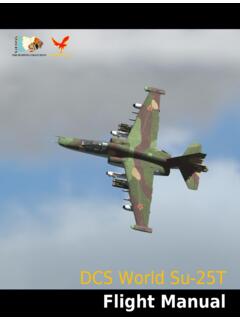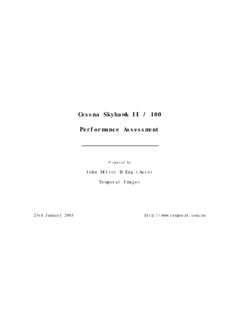Transcription of Supercarrier Operations Guide
1 Updated 14 June 2021 Operations Guide DCS [ Supercarrier Operations Guide ] 2 Contents LATEST CHANGES .. 4 THE NIMITZ CLASS AIRCRAFT CARRIER .. 5 Overview .. 6 Flight Deck Layout and Equipment .. 7 Catapults .. 7 Jet Blast Deflectors .. 8 Arresting gear .. 8 Hangar Bay .. 9 Elevators .. 10 Flight Deck Personnel .. 11 Instrument Approach Equipment .. 13 Tactical Air Navigation System (TACAN) .. 13 Instrument Carrier landing System (ICLS) .. 13 Automated Carrier landing System (ACLS) .. 13 Improved Fresnel Lens Optical landing System (IFLOLS).
2 14 Long Range Laser Lineup System .. 15 Additional Supercarrier Module Assets .. 16 LAUNCH Operations .. 17 Flight Deck 18 Catapult Procedures .. 19 Case I Departure .. 24 Case II Departure .. 25 Case III Departure .. 26 RECOVERY Operations .. 27 Overview .. 28 Case I Recovery .. 29 Marshal .. 29 See You at 10 .. 30 Holding Pattern .. 30 Breaking the 31 Overhead Break .. 32 In the Groove .. 33 landing .. 35 [ Supercarrier Operations Guide ] DCS EAGLE DYNAMICS 3 Touch and Go & Bolters .. 37 Waveoff.
3 37 Case II Recovery .. 38 Case III Recovery .. 39 Marshal .. 39 Approach .. 41 ACLS Lock .. 42 In the Groove .. 43 landing .. 45 Waveoff or Bolter .. 47 landing SIGNAL OFFICER (LSO) STATION .. 48 Overview .. 49 LSO Main Screen Window .. 50 LSO Main Screen Display .. 51 PLAT Camera View .. 52 MISSION EDITOR FEATURES .. 54 Overview .. 55 Ship Selection and Placement .. 56 Communications and Navigation Equipment .. 57 Radio Frequency .. 57 TACAN Channel .. 57 ICLS Channel .. 58 AI Aircraft Parking and Taxi Logic.
4 60 Static Object Placement .. 61 DCS [ Supercarrier Operations Guide ] 4 LATEST CHANGES Significant changes to the Guide will be noted on this page. Changes may be identified by a black bar next to the new or revised text as shown here in the right margin. 15 Apr 2020 First edition of the DCS: Supercarrier Operations Guide [ Supercarrier Operations Guide ] DCS EAGLE DYNAMICS 5 THE NIMITZ CLASS AIRCRAFT CARRIER DCS [ Supercarrier Operations Guide ] 6 Overview The Nimitz class aircraft carrier (CVN) is a set of ten nuclear powered aircraft carriers currently in service with the US Navy.
5 The general arrangement of these ships is like the previous Kitty Hawk class with a large flight deck with an island structure on the starboard side reaching nearly 20 stories tall. The angled deck used for landing is canted approximately 14 to port and is almost 800 feet long. Four high speed aircraft elevators, each more than 4,000 square feet, bring planes to the flight deck from the hangar below. Displacement: 72,916 tons light, 96,000 - 102,000 full load. Length: 1040 feet along the flight deck (317 meters).
6 Beam: 252 feet ( meters). Speed: 30+ knots ( + miles per hour). Power Plant: Two nuclear reactors, four geared steam turbines, four propellers (thirteen to fifteen years between refueling or 800,000 to 1,000,000 miles). Complement: 3,200 regular ship s compliment + 2,480 Air Wing personnel. Defense: Four NATO Sea Sparrow, three to four 20mm Vulcan Phalanx CIWS. Air Wing (including legacy): 70-80 aircraft including F-14s, F/A-18s, EA-6Bs, E-2Cs, S-3A/Bs, C-2s, SH-60Fs, HH-60Hs. The DCS: Supercarrier module represents the Theodore Roosevelt subclass of the Nimitz carrier, often referred to as the improved Nimitz class.
7 The hulls available here include: CVN-71 Theodore Roosevelt. (TR, Big Stick) Date commissioned: 25 Oct 1986 CVN-72 Abraham Lincoln. (Abe) Date commissioned: 11 Nov 1989 CVN-73 George Washington. (The Spirit of Freedom, GW, G-Dub) Date commissioned: 04 Jul 1992 [ Supercarrier Operations Guide ] DCS EAGLE DYNAMICS 7 Flight Deck Layout and Equipment The enormous flight deck of a Nimitz class carrier is the core of its offensive capability. During flight Operations , it is regarded as one of the most dangerous places in the world to work.
8 Catapults Four catapults are available to slingshot aircraft off the deck and into the air. Catapults one and two are located on the bow while catapults three and four are located on the waist. Together, on average these can launch one aircraft every 20 seconds. The launch is initiated by personnel situated in the Integrated Catapult Control Station (ICCS), also called the bubble . This is a small dome located between catapult 1 and 2 on the bow and left of catapult 4 on the waist. These are steam powered catapults with two cylinders running the length of each track.
9 A piston on each cylinder connects to a shuttle that extends out of each track. The launching aircraft taxis so the launch bar at its nose wheel connects to the shuttle. At launch, high pressure steam is ported into the cylinders. This forces the shuttle down the track at high speed, launching the aircraft. A water brake slows the shuttle at the end of the run so it can be retracted for the next launch. DCS [ Supercarrier Operations Guide ] 8 Jet Blast Deflectors These heavy-duty panels are located behind each catapult to deflect high speed exhaust produced by launching aircraft s engines.
10 hydraulic cylinders raise each panel into place upward at a 45 angle. A seawater cooling system is installed in each to prevent damage from hot engine exhaust. These are retracted when not in use and sit flush with the deck. Arresting gear Four steel arresting cables, also known as cross-deck pendants, span the landing area. The aircraft s tailhook connects to one of these cables on touchdown, hauling the aircraft to a stop in about 300 feet. The cables are made of braided steel strands with a polyester core for flexibility.










